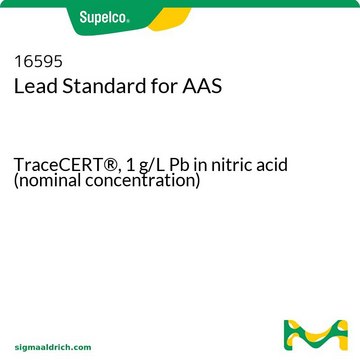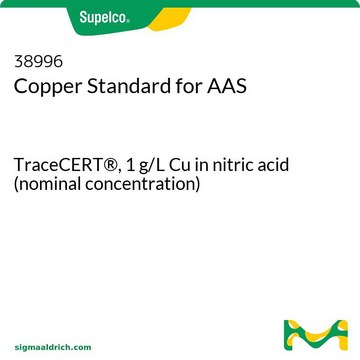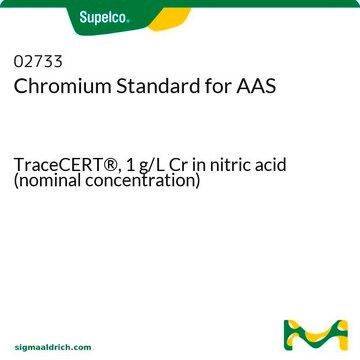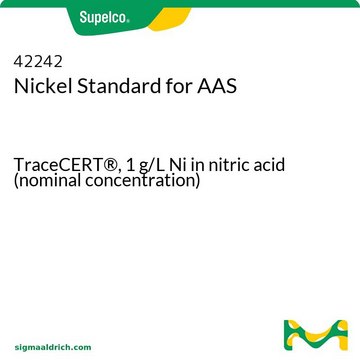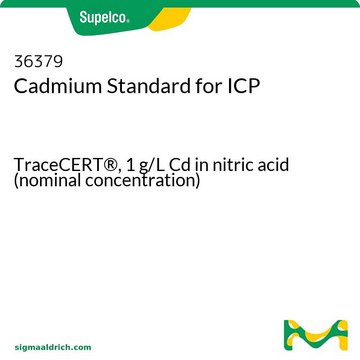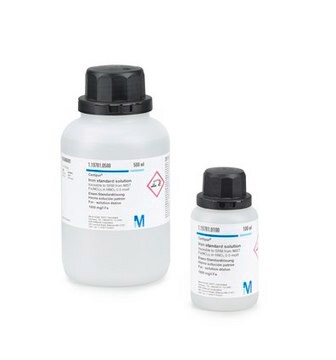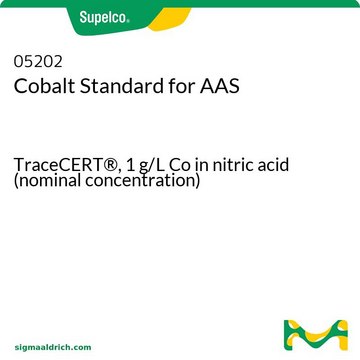51994
Cadmium Standard for AAS
TraceCERT®, 1 g/L Cd in nitric acid (nominal concentration)
About This Item
Recommended Products
grade
certified reference material
TraceCERT®
Quality Level
product line
TraceCERT®
concentration
1 g/L Cd in nitric acid (nominal concentration)
technique(s)
AAS: suitable
application(s)
agriculture
cleaning products
cosmetics
environmental
food and beverages
personal care
format
single component solution
General description
Certified content incl. uncertainty and expiry date are given on the certificate.
Download your certificate at: http://www.sigma-aldrich.com.
Application
- Vitamin B6-based Chemosensor: Pyridoxal 5′-phosphate, a Vitamin B6 derivative, is utilized in a fluorescence chemosensor for selective detection of fluoride ions. This research not only showcases the biochemical versatility of PLP but also its potential in developing sensitive diagnostic tools, enhancing our understanding of ion interactions in biological systems (Zavalishin et al., 2023).
- Biocompatible Protecting Groups: The study on biocompatible lysine protecting groups for the chemoenzymatic synthesis of ubiquitin chains highlights innovative uses of biochemical techniques where PLP could play a role in enzymatic processes. This research underpins the development of more efficient and selective synthetic methods in protein chemistry, which are crucial for therapeutic and research applications (Mikami et al., 2023).
- Aromatic Amino Acid Decarboxylase Function: Investigations into the structure and flexibility of human aromatic amino acid decarboxylase, which requires PLP as a cofactor, provide insights into genetic disorders like aromatic amino acid decarboxylase deficiency. This study enhances our understanding of the enzyme′s role in neurotransmitter synthesis, important for developing treatments for related metabolic disorders (Bisello et al., 2023).
Analysis Note
Other Notes
Legal Information
Signal Word
Danger
Hazard Statements
Precautionary Statements
Hazard Classifications
Carc. 1B - Eye Irrit. 2 - Met. Corr. 1 - Muta. 1B - Skin Irrit. 2 - STOT RE 2
Target Organs
Kidney,Bone
Storage Class Code
6.1D - Non-combustible acute toxic Cat.3 / toxic hazardous materials or hazardous materials causing chronic effects
WGK
WGK 3
Flash Point(F)
Not applicable
Flash Point(C)
Not applicable
Personal Protective Equipment
Choose from one of the most recent versions:
Already Own This Product?
Find documentation for the products that you have recently purchased in the Document Library.
Customers Also Viewed
Articles
Testing for heavy metals in food and beverages? You understand that prolonged trace exposure to heavy metals such as arsenic (As), cadmium (Cd), chromium (Cr), lead (Pb), mercury (Hg), and thallium (Tl), via the food, beverages and drinking water we consume can cause serious health risks. Fortunately, increasingly sensitive tests are in place to ensure our food is safe. Discover the recent advances in analytical technologies for heavy metal detection and the products, services and technical support available to help you keep us all safe. Because we all want to trust what we eat.
Our team of scientists has experience in all areas of research including Life Science, Material Science, Chemical Synthesis, Chromatography, Analytical and many others.
Contact Technical Service